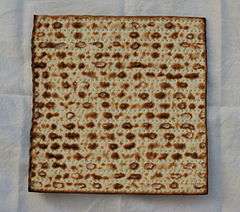Unleavened bread
| Type | Bread (usually flat bread) |
|---|---|
| Variations | Matzo, roti, tortilla, and many others |
|
| |
Unleavened bread is any of a wide variety of breads which are not prepared with raising agents. Unleavened breads are generally flat breads; however, not all flat breads are unleavened. Unleavened breads, such as the tortilla and roti, are staple foods in Central America and South Asia, respectively.
Religious significance
Unleavened breads have symbolic importance in Judaism and Christianity. Jews consume unleavened breads such as matzo during Passover. They are also used in the Western Christian liturgy when Christians perform the Eucharist, a rite derived from the Last Supper when Jesus broke bread with his disciples during a Passover Seder.
Canon Law of the Latin Rite of the Roman Catholic Church mandates the use of unleavened bread for the Host, and unleavened wafers for the communion of the faithful. The more liturgical Protestant churches tend to follow the Latin Catholic practice, whereas others use either unleavened bread or wafers or ordinary (leavened) bread, depending on the traditions of their particular denomination or local usage.
On the other hand, most Eastern Churches explicitly forbid the use of unleavened bread (Greek: azymes) for Eucharist as pertaining to the Old Testament and allow only for bread with yeast, as a symbol of the New Covenant in Christ's blood. Indeed, this was one of the three points of contention that are, in traditional legend, accounted as those that brought about the Great Schism between Eastern and Western churches (the others being Petrine supremacy and the filioque in the Niceno-Constantinopolitan Creed).[1]
Varieties of unleavened bread
- Matzo – Jewish flat bread
- Tortilla – Mesoamerican/Mexican flat bread
- Roti – South Asian flat breads including Chapati, Dalpuri, and variants.
References
- ↑ Ware, Timothy (1964), The Orthodox Church, London: Penguin Books, p. 66, ISBN 0-14-020592-6
